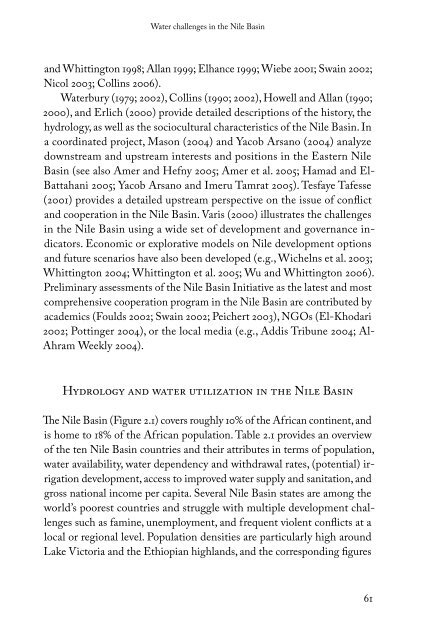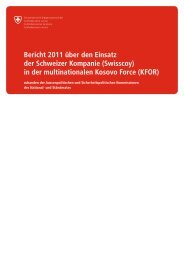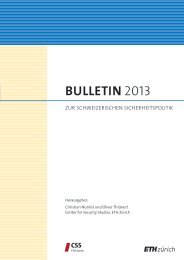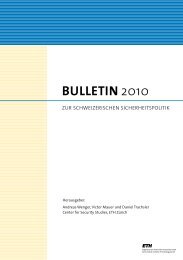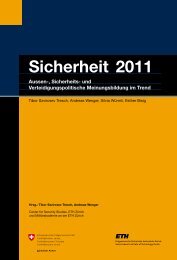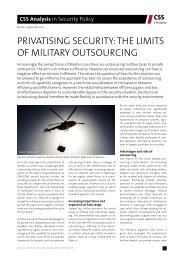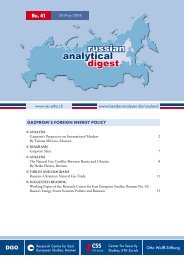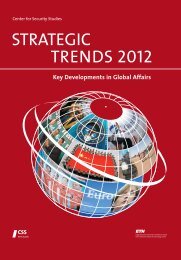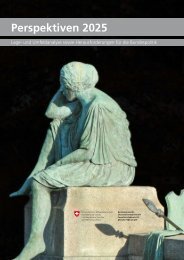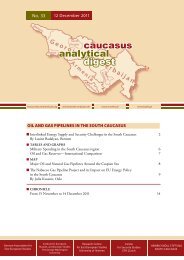Double-Edged Hydropolitics on the Nile - Center for Security Studies ...
Double-Edged Hydropolitics on the Nile - Center for Security Studies ...
Double-Edged Hydropolitics on the Nile - Center for Security Studies ...
Create successful ePaper yourself
Turn your PDF publications into a flip-book with our unique Google optimized e-Paper software.
Water challenges in <strong>the</strong> <strong>Nile</strong> Basin<br />
and Whittingt<strong>on</strong> 1998; Allan 1999; Elhance 1999; Wiebe 2001; Swain 2002;<br />
Nicol 2003; Collins 2006).<br />
Waterbury (1979; 2002), Collins (1990; 2002), Howell and Allan (1990;<br />
2000), and Erlich (2000) provide detailed descripti<strong>on</strong>s of <strong>the</strong> history, <strong>the</strong><br />
hydrology, as well as <strong>the</strong> sociocultural characteristics of <strong>the</strong> <strong>Nile</strong> Basin. In<br />
a coordinated project, Mas<strong>on</strong> (2004) and Yacob Arsano (2004) analyze<br />
downstream and upstream interests and positi<strong>on</strong>s in <strong>the</strong> Eastern <strong>Nile</strong><br />
Basin (see also Amer and Hefny 2005; Amer et al. 2005; Hamad and El-<br />
Battahani 2005; Yacob Arsano and Imeru Tamrat 2005). Tesfaye Tafesse<br />
(2001) provides a detailed upstream perspective <strong>on</strong> <strong>the</strong> issue of c<strong>on</strong>flict<br />
and cooperati<strong>on</strong> in <strong>the</strong> <strong>Nile</strong> Basin. Varis (2000) illustrates <strong>the</strong> challenges<br />
in <strong>the</strong> <strong>Nile</strong> Basin using a wide set of development and governance indicators.<br />
Ec<strong>on</strong>omic or explorative models <strong>on</strong> <strong>Nile</strong> development opti<strong>on</strong>s<br />
and future scenarios have also been developed (e.g., Wichelns et al. 2003;<br />
Whittingt<strong>on</strong> 2004; Whittingt<strong>on</strong> et al. 2005; Wu and Whittingt<strong>on</strong> 2006).<br />
Preliminary assessments of <strong>the</strong> <strong>Nile</strong> Basin Initiative as <strong>the</strong> latest and most<br />
comprehensive cooperati<strong>on</strong> program in <strong>the</strong> <strong>Nile</strong> Basin are c<strong>on</strong>tributed by<br />
academics (Foulds 2002; Swain 2002; Peichert 2003), NGOs (El-Khodari<br />
2002; Pottinger 2004), or <strong>the</strong> local media (e.g., Addis Tribune 2004; Al-<br />
Ahram Weekly 2004).<br />
Hydrology and water utilizati<strong>on</strong> in <strong>the</strong> <strong>Nile</strong> Basin<br />
The <strong>Nile</strong> Basin (Figure 2.1) covers roughly 10% of <strong>the</strong> African c<strong>on</strong>tinent, and<br />
is home to 18% of <strong>the</strong> African populati<strong>on</strong>. Table 2.1 provides an overview<br />
of <strong>the</strong> ten <strong>Nile</strong> Basin countries and <strong>the</strong>ir attributes in terms of populati<strong>on</strong>,<br />
water availability, water dependency and withdrawal rates, (potential) irrigati<strong>on</strong><br />
development, access to improved water supply and sanitati<strong>on</strong>, and<br />
gross nati<strong>on</strong>al income per capita. Several <strong>Nile</strong> Basin states are am<strong>on</strong>g <strong>the</strong><br />
world’s poorest countries and struggle with multiple development challenges<br />
such as famine, unemployment, and frequent violent c<strong>on</strong>flicts at a<br />
local or regi<strong>on</strong>al level. Populati<strong>on</strong> densities are particularly high around<br />
Lake Victoria and <strong>the</strong> Ethiopian highlands, and <strong>the</strong> corresp<strong>on</strong>ding figures<br />
61


